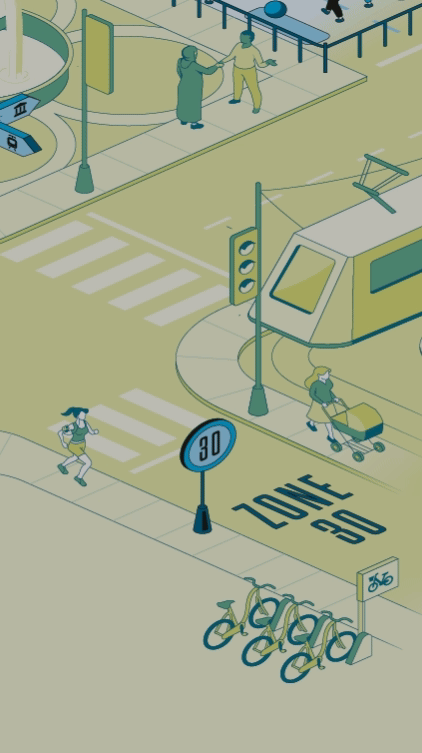Media
Enhancing urban liveability: 7 leading cities
7 examples of liveable cities
What makes a city a pleasant place to live? If it is green, quiet, safe and inclusive. These seven examples show what can happen when urban and transportation planners put people first.

More flora: Seoul, South Korea
When cars disappear, nature can move in to reclaim the space. Take Seoul, for example: In 2017, a former highway in the heart of the city with 10 million residents was transformed into an airy urban garden, the Skygarden Seoullo 7017. This nearly one-kilometer-long walkway gave rise to a botanical library that features more than 24,000 plants organized alphabetically by genus. Cafés, viewpoints and play areas offer even more reasons to linger.

Less pollution: Chengdu, China
While clean air is a basic human right, in most large cities, air pollution from fine dust particles is especially high. The solution to this problem is simple and can be found in nature. All you need is a concrete wall, as the Chinese city of Chengdu has demonstrated. There, the viaducts along a central main road are almost entirely covered with Boston ivy. Climbing plants, which produce several square meters of leaf surface per square meter of wall, are among the most effective air purifiers because they absorb harmful nitrogen oxides and capture fine dust particles.

More time: Portland, United States
Getting stuck in traffic is annoying and time-consuming. One way to avoid this is to skip the drive, now an option thanks to the 15-minute city. The idea behind this urban planning concept is to make everyday destinations accessible by foot, bike or public transportation within roughly 15 minutes. Portland is one of the pioneers of this concept in the United States. Since the project started in 2009, car traffic has been reduced by 20 percent. The city expanded pedestrian and bike paths, improved public transportation, opened new parks and subsidized a mix of apartments, commercial buildings and shops in numerous districts.

Less noise: Helsinki, Finland
Traffic noise is impossible to escape, especially in densely populated cities. This has far-reaching consequences: In Europe alone, at least one in five people is exposed to harmful noise levels of 55 decibels or more. How can we reduce traffic noise? Helsinki is setting an example with a speed limit of 30 km/h across nearly the entire city. This increases safety and reduces noise, as cars are quieter at slower speeds. Once they accelerate to above 30 km/h, the noise of the tires on the surface of the road is even louder than the sound of the engine.

More inclusion: Singapore
Mobility and quality of life are two things that go hand in hand. To allow seniors to keep enjoying the latter, Singapore started the Green Man+ initiative, which now includes more than 1,000 traffic lights. If you hold a senior citizen card issued by the city’s public transport company up to the traffic lights, this will extend the green light by up to 13 seconds. There are also “heart zones” at bus and tram stops. Anyone standing in this zone signals that they require assistance with their journey. The aim is to encourage other passengers to help those who need it.

Less risk: Paris, France
Car traffic is a safety hazard for schoolchildren. In an unparalleled push to minimize the risk, Paris created a host of new pedestrian zones in 2020: As part of the “Rues aux Écoles” (school streets) initiative, streets close to schools were shut off to private vehicle traffic. This has resulted in more than 200 mini-pedestrian zones to date, and the aim is to reach 300 by the year 2026. These new pedestrian friendly areas, which are often landscaped, notonly make it safer for children to walk to and from school, but they also provide more space to play and run around safely, especially in densely populated parts of the city on the Seine.

More interaction: London, England
How can you build for the future from the relics of a car-centric city? Here is one way: In London’s Peckham neighborhood, the architecture firm Turner Works saw an unsightly parking garage as an opportunity instead of an eyesore. In partnership with the nonprofit enterprise Make Shift, they converted seven levels of the garage into a creative space for people to interact. Artists now have access to affordable studios and can engage with interested visitors through exhibitions and public coworking spaces.



